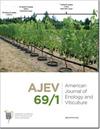在密苏里种植的葡萄品种中发现的病毒调查
IF 1.8
3区 农林科学
Q3 BIOTECHNOLOGY & APPLIED MICROBIOLOGY
引用次数: 10
摘要
2017年,一项针对密苏里州葡萄园的调查发现了19种不同的葡萄藤病毒。共收集了25个葡萄品种的400个样品,样品由16个叶柄组成(4个叶柄来自4个不同的葡萄藤)。在葡萄园块内的抽样是随机的,不考虑是否存在症状。从叶柄样品中提取核酸后,采用逆转录-定量聚合酶链反应(RT-qPCR)对核酸样品进行分析,检测病毒RNA/DNA。在90%的样本中至少检测到一种病毒。调查中检测到的最常见的病毒是葡萄树枯茎侵蚀相关病毒,在59%的样品中发现,其次是葡萄树叶卷相关病毒3(53%)、葡萄树红斑病毒(35%)、葡萄树E病毒(31%)、葡萄树叶卷相关病毒2(19%)、葡萄树B病毒(17%)、葡萄树斑点病毒(13.5%)、葡萄树叶卷相关病毒2红球病毒(9%)、葡萄树清静脉病毒(8%)、葡萄树A病毒(0.5%)、葡萄叶相关病毒4株5(0.2%)。65%的样本中检测到两种或两种以上的病毒,一个样本中检测到7种病毒的上限。对调查结果的分析表明,每个葡萄品种似乎都受到特定病毒组合的感染,这些病毒组合在很大程度上是该品种所特有的。本文章由计算机程序翻译,如有差异,请以英文原文为准。
A Survey of Viruses Found in Grapevine Cultivars Grown in Missouri
In 2017 a survey was initiated of vineyards throughout Missouri for the presence of 19 different grapevine viruses. A total of 400 samples were collected from 25 grape cultivars, with a sample consisting of 16 petioles (four petioles from four different vines). Sampling within vineyard blocks was random, without regard to the presence or absence of symptoms. After nucleic acids were extracted from petiole samples, nucleic acid samples were analyzed using reverse transcriptase-quantitative polymerase chain reaction (RT-qPCR) to detect viral RNA/DNA. At least one virus was detected in 90% of the samples. The most common virus detected in the survey was grapevine rupestris stem pitting-associated virus, which was found in 59% of the samples, followed by grapevine leafroll-associated virus 3 (53%), grapevine red blotch virus (35%), grapevine virus E (31%), grapevine leafroll-associated virus 2 (19%), grapevine virus B (17%), grapevine fleck virus (13.5%), grapevine leafroll-associated virus-2 Redglobe (9%), grapevine vein clearing virus (8%), grapevine virus A (0.5%), and grapevine leafroll-associated virus 4 strain 5 (0.2%). Two or more viruses were detected in ~65% of the samples, with an upper limit of seven viruses detected in one sample. An analysis of the survey results indicated that each grapevine cultivar appears to be infected by specific virus combinations that are, for the most part, unique to that cultivar.
求助全文
通过发布文献求助,成功后即可免费获取论文全文。
去求助
来源期刊

American Journal of Enology and Viticulture
农林科学-生物工程与应用微生物
CiteScore
3.80
自引率
10.50%
发文量
27
审稿时长
12-24 weeks
期刊介绍:
The American Journal of Enology and Viticulture (AJEV), published quarterly, is an official journal of the American Society for Enology and Viticulture (ASEV) and is the premier journal in the English language dedicated to scientific research on winemaking and grapegrowing. AJEV publishes full-length research papers, literature reviews, research notes, and technical briefs on various aspects of enology and viticulture, including wine chemistry, sensory science, process engineering, wine quality assessments, microbiology, methods development, plant pathogenesis, diseases and pests of grape, rootstock and clonal evaluation, effect of field practices, and grape genetics and breeding. All papers are peer reviewed, and authorship of papers is not limited to members of ASEV. The science editor, along with the viticulture, enology, and associate editors, are drawn from academic and research institutions worldwide and guide the content of the Journal.
 求助内容:
求助内容: 应助结果提醒方式:
应助结果提醒方式:


